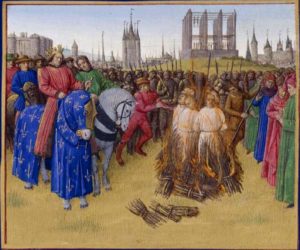
The next time you’re in Paris, stop by 53, rue de la Grange aux Belles (10e). You’ll be standing in front of a garage with apartments built on top—sounds exciting, huh? Seven hundred or so years ago, this was a pretty scary site. You never wanted to end up here.
You are standing in an area that was once part of the countryside outside the medieval walls of Paris. Standing here, you would have had a pretty good view of the city. You’re on a hill (actually, more like a mound). The area we now call Montmartre would have been visible to you toward the northwest. Surrounding you would have been the leper colony of St. Lazare, the Convent of the Filles-Dieu (a home for prostitutes), and the original Hôpital Saint-Louis. Clearly, the king did not want any undesirable elements with the walls of his city.
Hanging Around
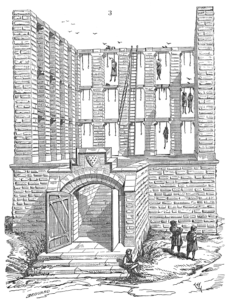
One of the monarch’s most undesirable icons stood in front of you. It was the Gibet de Montfaucon (Gibbet/Gallows of Montfaucon). Erected around the late 13th century, the gibbet was used until 1629 and finally dismantled in 1760. The structure was used to hang people and to display the bodies of the executed (both local and imported). There are written accounts of the executed being displayed here for more than three years before they were either posthumously exonerated or whatever remained of the body was turned over to the family.
The gibbet was erected on land once owned by Count Falco (Faucon). Since it was a hill or mound (mont), the gibbet became known as Montfaucon. Its nickname was “Forks of the great justice.” The best description and image of the structure comes from a drawing by Eugène Viollet-le-Duc. It was an imposing three-sided structure: 20 feet high, 46 feet long, and 39 feet wide. There were 45 “compartments” to either hang or exhibit the victims’ bodies.
It’s Good and Bad To Be The King’s Friend
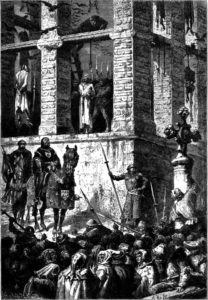
On 30 April 1315, a rather obscure noble, Enguerrand de Marigny (1260–1315), was hanged after being accused of sorcery. He had been King Philippe IV’s finance minister, and since the king was a spendthrift, Enguerrand’s job was to constantly raise money. He was not well liked by people within the orbit of the king: he wasn’t a very nice person. When Philippe died in 1314, his son (Louis X) had Enguerrand arrested for bribery. When that didn’t stick, Louis used the up–and–coming threat of sorcery. That did the trick, and Enguerrand was strung up on the gibbet. Louis eventually repented his decision and returned Enguerrand’s estate to his heirs (presumably along with his remains).
Where Exactly Was The Gibbet?
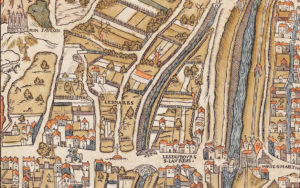
There are various areas nearby cited as the original location of the Gibet de Montfaucon (e.g., the Parc des Buttes-Chaumont or the area bounded by Avenue Secrétan and Rue de Meaux). In 1954, the construction of the garage you’re standing in front of revealed the bases of two stone pillars and human remains. It was generally thought this evidence was enough to support the location of the gibbet.
Quasimodo and Esmeralda
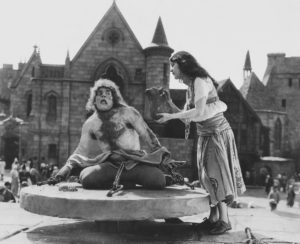
“We have just said that Quasimodo disappeared from Notre-Dame on the day of the gypsy’s and of the archdeacon’s death. He was not seen again, in fact; no one knew what had become of him. At the end of the fifteenth century, the formidable gibbet which dated from 1328, was already very much dilapidated; the beams were worm-eaten, the chains rusted, the pillars green with mould; the layers of hewn stone were all cracked at their joints, and grass was growing on that platform which no feet touched. The monument made a horrible profile against the sky; especially at night when there was a little moonlight on those white skulls, or when the breeze of evening brushed the chains and the skeletons, and swayed all these in the darkness. As for the mysterious disappearance of Quasimodo, this is all that we have been able to discover. One of these skeletons, which was that of a woman, still had a few strips of a garment which had once been white. The other, which held this one in a close embrace, was the skeleton of a man. It was noticed that his spinal column was crooked, his head seated on his shoulder blades, and that one leg was shorter than the other. Moreover, there was no fracture of the vertebrae at the nape of the neck, and it was evident that he had not been hanged. Hence, the man to whom it had belonged had come thither and had died there. When they tried to detach the skeleton which he held in his embrace, he fell to dust.” — The Hunchback of Notre Dame by Victor Hugo (translated by Isabel F. Hapgood).
Midnight Visits
Most of the top-ten lists of scary places in Paris list this street as a place to visit. It is said that if you stand near 53, rue de la Grange aux Belles late at night and listen carefully, you will hear the rattle of chains and the moans of the gibbet’s victims.
“Memo to wannabe Bravehearts: The 13th century wasn’t all that fun.”
— Bret Stephens, Columnist, Wall Street Journal.
What’s New With Sandy and Stew
We hope you like our new web-site design. Keep visiting us for new exciting updates. Please let us know your comments and suggestions by clicking on Contact at the top of the page or Talk to Stew at the bottom of the page.
New Books

 Today’s blog describes several locations where I will take you in the next two books: Where Did They Burn the Last Grand Master of the Knights Templar? – Volumes One and Two: Jacque de Molay’s Curse and The Royal Crypts, respectively. We are about ready to go to print on Volume One while Volume Two will be done only as an ePub version.
Today’s blog describes several locations where I will take you in the next two books: Where Did They Burn the Last Grand Master of the Knights Templar? – Volumes One and Two: Jacque de Molay’s Curse and The Royal Crypts, respectively. We are about ready to go to print on Volume One while Volume Two will be done only as an ePub version.
I’m excited to get back to work on the next series of walking tour books covering the Nazi occupation of Paris between 1940 and 1944. Over the foreseeable future, I will devote some of the blogs to sites that were significant during the Occupation of Paris. I hope you enjoy the abbreviated stories and perhaps they may spark an interest in my new book (coming soon).
WHERE DID THEY PUT THE GESTAPO HEADQUARTERS? A WALKING TOUR OF NAZI OCCUPIED PARIS (1940–1944)
Someone Is Commenting On Our Blogs
If there is a topic you’d like to see a blog written about, please don’t hesitate to contact me. I love hearing from you so keep those comments coming.
We have a lot of stories and we’re looking forward to sharing these with you. Please continue to visit our blog site and perhaps you’d like to subscribe so that you don’t miss out on our blog posts, past and current.
We need your help
Please tell your friends about our blog site and encourage them to visit and subscribe. Sandy and I are trying to increase our audience and we need your help through your friends and social media followers.
Thank You
Sandy and I appreciate you visiting with us. We have some exciting things on the horizon and we’ll keep you updated as we go along.
Share This:
Follow Stew:
Find Stew’s books on Amazon and iBooks.
Please note that we do not and will not take compensation from individuals or companies mentioned or promoted in the blogs.
Walks Through History
Copyright © 2016 Stew Ross



